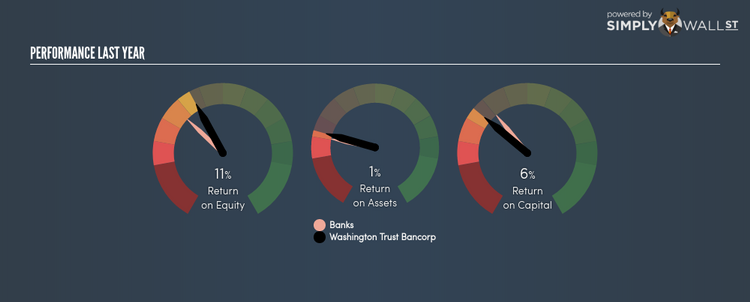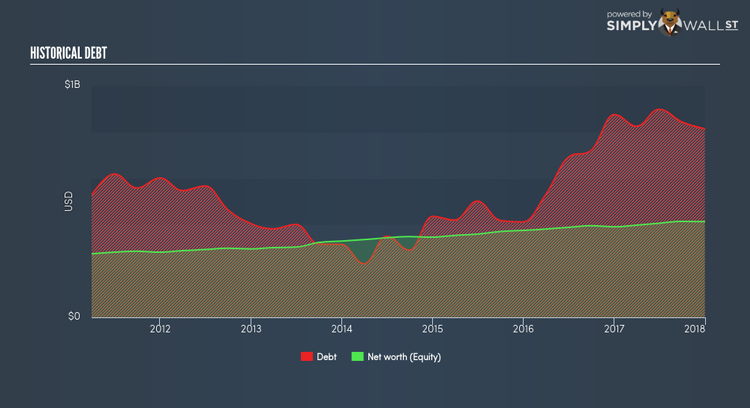What is Behind Washington Trust Bancorp Inc’s (NASDAQ:WASH) Superior ROE?

Washington Trust Bancorp Inc (NASDAQ:WASH) outperformed the Regional Banks industry on the basis of its ROE – producing a higher 11.42% relative to the peer average of 8.57% over the past 12 months. Superficially, this looks great since we know that WASH has generated big profits with little equity capital; however, ROE doesn’t tell us how much WASH has borrowed in debt. Today, we’ll take a closer look at some factors like financial leverage to see how sustainable WASH’s ROE is. See our latest analysis for Washington Trust Bancorp
Breaking down Return on Equity
Return on Equity (ROE) weighs Washington Trust Bancorp’s profit against the level of its shareholders’ equity. For example, if the company invests $1 in the form of equity, it will generate $0.11 in earnings from this. While a higher ROE is preferred in most cases, there are several other factors we should consider before drawing any conclusions.
Return on Equity = Net Profit ÷ Shareholders Equity
Returns are usually compared to costs to measure the efficiency of capital. Washington Trust Bancorp’s cost of equity is 9.87%. Since Washington Trust Bancorp’s return covers its cost in excess of 1.55%, its use of equity capital is efficient and likely to be sustainable. Simply put, Washington Trust Bancorp pays less for its capital than what it generates in return. ROE can be broken down into three different ratios: net profit margin, asset turnover, and financial leverage. This is called the Dupont Formula:
Dupont Formula
ROE = profit margin × asset turnover × financial leverage
ROE = (annual net profit ÷ sales) × (sales ÷ assets) × (assets ÷ shareholders’ equity)
ROE = annual net profit ÷ shareholders’ equity
Essentially, profit margin shows how much money the company makes after paying for all its expenses. Asset turnover shows how much revenue Washington Trust Bancorp can generate with its current asset base. And finally, financial leverage is simply how much of assets are funded by equity, which exhibits how sustainable the company’s capital structure is. Since ROE can be inflated by excessive debt, we need to examine Washington Trust Bancorp’s debt-to-equity level. The debt-to-equity ratio currently stands at a high 196.97%, meaning the above-average ratio is a result of a large amount of debt.
Next Steps:
ROE is one of many ratios which meaningfully dissects financial statements, which illustrates the quality of a company. Washington Trust Bancorp exhibits a strong ROE against its peers, as well as sufficient returns to cover its cost of equity. With debt capital in excess of equity, ROE may be inflated by the use of debt funding, raising questions over the sustainability of the company’s returns. Although ROE can be a useful metric, it is only a small part of diligent research.
For Washington Trust Bancorp, there are three relevant factors you should further examine:
1. Financial Health: Does it have a healthy balance sheet? Take a look at our free balance sheet analysis with six simple checks on key factors like leverage and risk.
2. Valuation: What is Washington Trust Bancorp worth today? Is the stock undervalued, even when its growth outlook is factored into its intrinsic value? The intrinsic value infographic in our free research report helps visualize whether Washington Trust Bancorp is currently mispriced by the market.
3. Other High-Growth Alternatives : Are there other high-growth stocks you could be holding instead of Washington Trust Bancorp? Explore our interactive list of stocks with large growth potential to get an idea of what else is out there you may be missing!
To help readers see pass the short term volatility of the financial market, we aim to bring you a long-term focused research analysis purely driven by fundamental data. Note that our analysis does not factor in the latest price sensitive company announcements.
The author is an independent contributor and at the time of publication had no position in the stocks mentioned.


